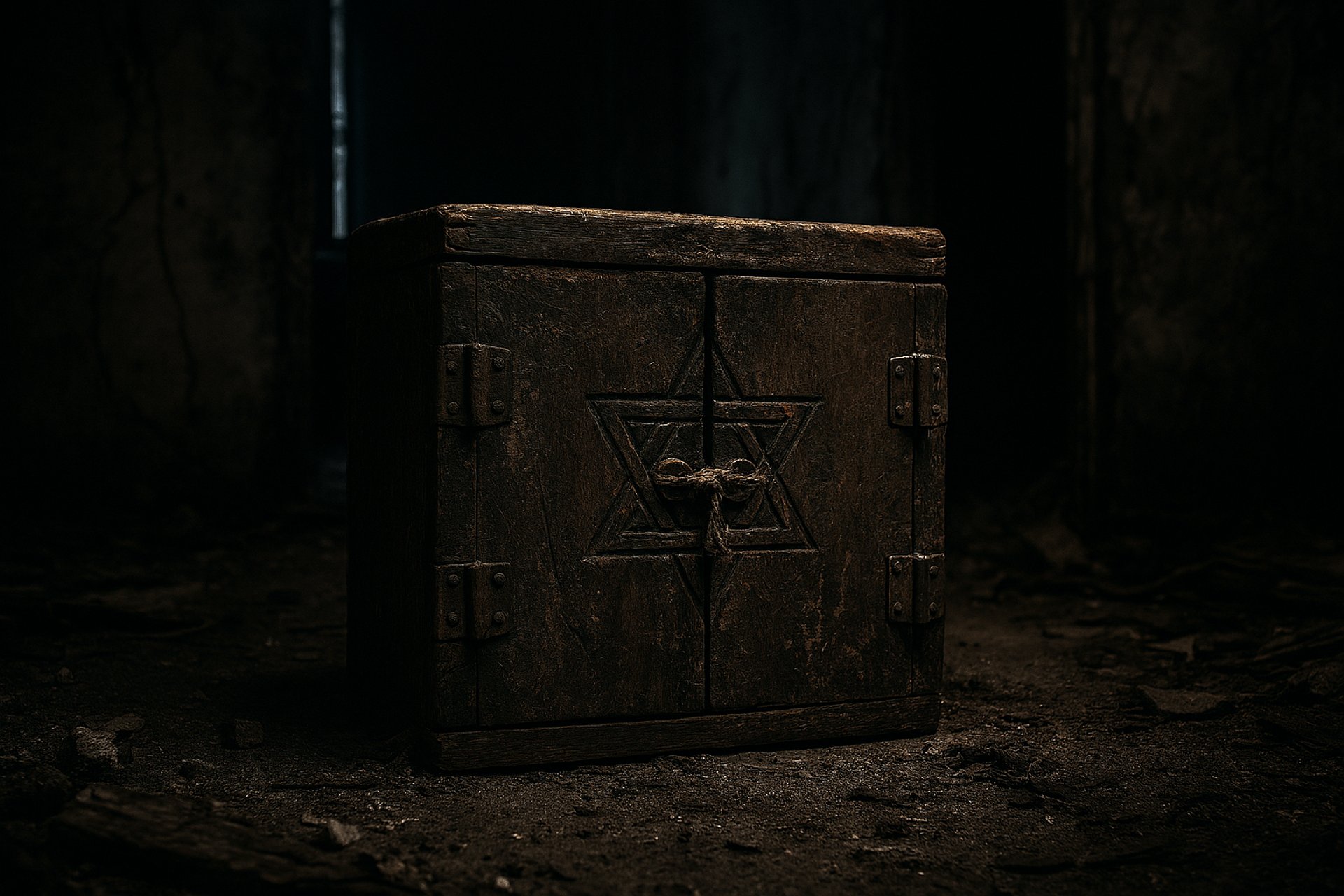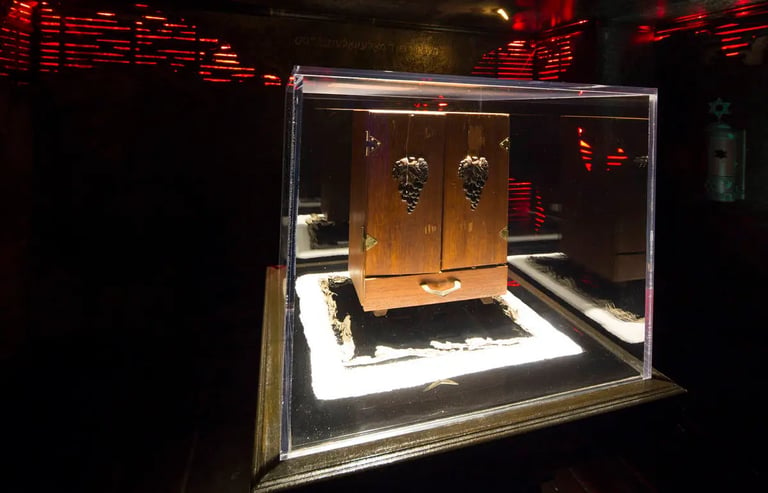
Episode 5 - The Dybbuk Box
Episode 2 - The Dybbuk Box - Blog about the show, make sure to check us out on your favorite podcast platform!
PARANORMAL
Daniel



The Dybbuk Box
The story of the Dybbuk Box is a chilling modern legend that intertwines ancient Jewish folklore with a seemingly cursed object, weaving a tapestry of misfortune, terror, and the unexplainable that has captivated and terrified people worldwide.
What is a Dybbuk?
To understand the box, one must first understand the spirit it is said to contain. In Jewish folklore, a dybbuk is the restless, malevolent spirit of a deceased person, typically male, who cannot find peace due to past sins. It roams aimlessly until it attaches itself to a living person, “clinging” (from the Hebrew root davek) to a host in search of relief or to wreak havoc.
Belief in these entities was widespread in Eastern European Jewish communities from the 16th century onward, particularly with the rise of mystical Kabbalistic teachings in Tzfat, Galilee. Isaac Luria, a prominent Kabbalist, laid the groundwork with his concepts of soul transmigration. His followers expanded this to include the idea of dybbuk possession, often blamed for sudden mental or emotional disturbances. The only remedy was thought to be a formal exorcism performed by a skilled rabbi.
The Origins of the Dybbuk Box
The infamous object’s story begins in 2003. Kevin Mannis, a furniture refinisher from Portland, Oregon, purchased a vintage, two-drawer wine cabinet at an estate sale. The cabinet, he was told, had a dark history: it was originally owned by a Jewish family in Spain who had fled before the Spanish Civil War and was used to trap a dybbuk.
Initially captivated by its craftsmanship, Mannis soon regretted his purchase. Almost immediately, his home was plagued by a foul odor, flickering lights, and an oppressive feeling of being watched. Most disturbingly, his ill mother suffered a sudden and dramatic decline in health. Convinced the cabinet was cursed, Mannis decided to sell it.
A Trail of Misfortune: The Owners’ Tales
The Dybbuk Box would change hands multiple times, leaving a wake of chaos and tragedy for each successive owner.
Jason Haxton (2004-2007) Jason Haxton, a museum director and collector of the unusual, bought the box from Mannis. His intention to study it quickly gave way to survival. He developed severe, unexplained respiratory ailments—coughing fits, shortness of breath, and chest pain that baffled doctors. His life descended into a nightmare: constant paranoia, vivid dreams of shadow figures, and poltergeist activity in his home. Objects moved, electronics failed, and unexplained scratching and whispering sounds became a constant backdrop. After three years of torment, Haxton sold the box.
The Antique Dealers (2007-2009) A couple who owned an antique store purchased the box next, unaware of its reputation. Their fortune reversed instantly. Their thriving business inexplicably collapsed. Their personal lives were shattered when the wife developed a rare, debilitating illness and the husband was seriously injured in a car accident. Their home, like Haxton’s, became a site of disturbing activity. They soon linked their sudden ruin to the cabinet and desperately sold it.
The Paranormal Investigator (2009-2011) A professional paranormal investigator acquired the box, hoping to document its power. Instead, they became the subject of their own horror story. Their family fell ill with severe, unexplained symptoms. The investigator documented intense activity: objects flying off shelves, relentless electronic failures, and the now-characteristic nightmares and whispering. The negative energy proved too much to handle, and the box was sold again.
The Student’s Nightmare (2011-2014) A university student with an interest in the paranormal brought the box into their apartment. The result was a textbook haunting: disturbing nightmares, unexplained footsteps and whispers, and objects moving on their own. The terror affected the student’s roommates and destroyed their academic focus. The student was eventually forced to move out to escape the oppressive atmosphere.
The Author’s Struggle (2014-2017) An author specializing in paranormal topics bought the box for research. It effectively ended their work. The author’s creative process was shattered by interruptions, a pervasive sense of dread, and frequent technical failures that erased their writing. The psychological toll—insomnia, anxiety, and nightmares—became unbearable, forcing the author to abandon their project and sell the box.
The Museum Collection: Zach Bagans (2017-Present)
The box found its most famous home in 2017 when it was acquired by Zak Bagans, host of “Ghost Adventures” and owner of The Haunted Museum in Las Vegas. There, it remains a centerpiece of his collection. Bagans and his team have documented ongoing phenomena associated with it, including eerie sounds and images. Museum visitors frequently report sudden chills, nausea, dizziness, and an intense feeling of being watched when near the display, continuing the box’s legacy of unsettling all who encounter it.
The Ritual of Exorcism in Jewish Tradition
The concept of containing a dybbuk is rooted in a serious spiritual practice. Though exorcism is often associated with Catholicism, Judaism has its own intricate, centuries-old rituals for expelling a dybbuk.
The process is not taken lightly. Rabbis first determine if the afflicted person is truly possessed or suffering from a medical or psychological condition. Once confirmed, a minyan (a group of ten Jewish adults) prepares through fasting and ritual purification. The exorcist, who must be deeply devout, confronts the dybbuk directly, recounting its sins to force it to reveal its name—a crucial step for expulsion.
Unlike sensationalized portrayals, the goal is not only to remove the spirit but to repair its soul (tikkun), separating its good aspects to return to the Treasury of Souls and allowing the bad to wither away. The spirit is believed to exit the body from where it entered, often marked by a physical sign like a bloody nail. The practice, though rare today, underscores the profound cultural and spiritual gravity behind the legend of the dybbuk.
Conclusion
The Dybbuk Box stands at the intersection of ancient folklore and modern legend. Is it a genuine vessel for a malevolent spirit, a powerful psychological trigger, or simply a story that has taken on a life of its own? Whatever the truth, its chilling narrative continues to captivate, serving as a potent reminder of humanity’s enduring fascination with the unknown and the eternal battle between light and darkness.


